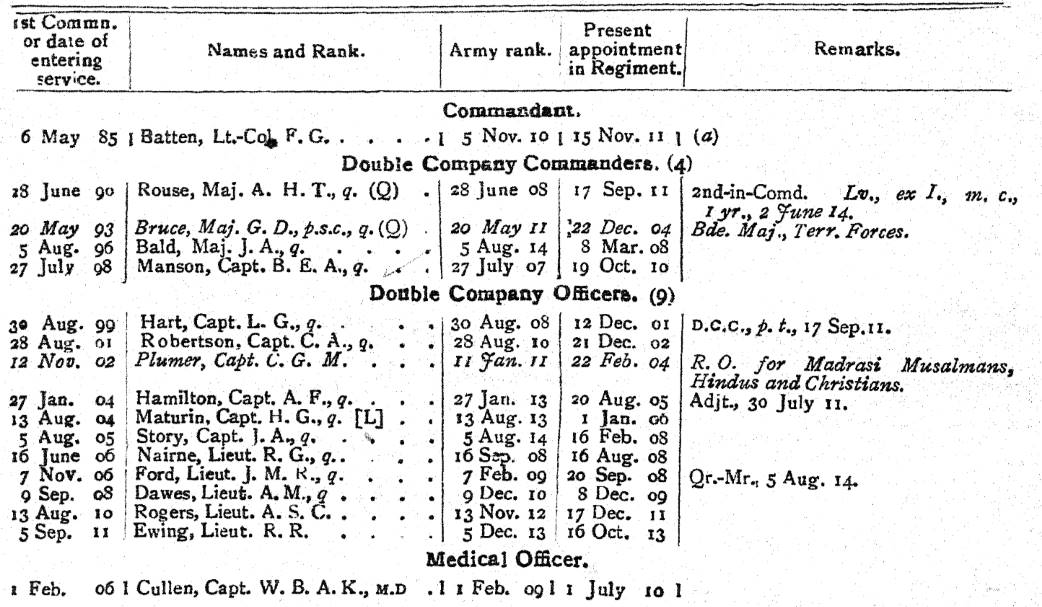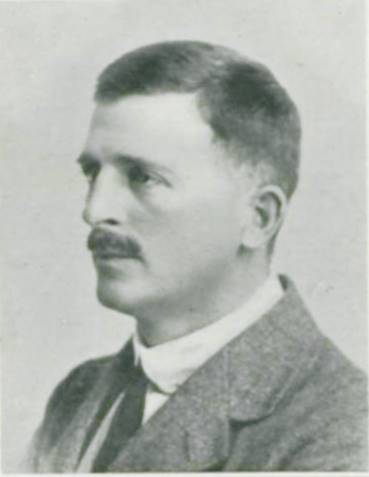This article looks at the 61st King George’s Own Pioneers and will help you research those who served with the Regiment during the First World War. I have also written an article on the war-raised 2nd Battalion 61st King George’s Own Pioneers and a series of guides to help you research soldiers who served in the Indian Army during the war:
- Guide to the 2nd Battalion 61st King George’s Own Pioneers
- Guides to Researching Soldiers who served in the Indian Army
The 61st King George’s Own Pioneers in the First World War
Lineage: Formed at Fort St. George (Madras now Chennai) in December 1758 from independent companies and was known as the 1st Battalion of Coast Sepoys. In 1769 it became the 1st Carnatic Battalion and then the 1st Madras Battalion in 1784. In 1796 it became the 1st Battalion, 1st Regiment, Madras Native Infantry and was disbanded in 1806. The Regiment was reformed as the 1st Battalion, 24th Regiment of Madras Native Infantry in 1807 and became the 1st Regiment of Madras Native Infantry in 1824. Then in 1883, the Regiment became the 1st Regiment of Madras Native Infantry (Pioneers) and then the 1st Regiment of Madras Infantry (Pioneers) in 1885. In 1901 it became the 1st Madras Pioneers and then the 61st Pioneers in 1903. Then in 1906 the 61st Prince of Wales’s Own Pioneers, then the 61st King George’s Own Pioneers in 1910 and the 1st Battalion 1st Madras Pioneers in 1922.
Composition in 1914: 4 Companies of Tamils, 2 of Madrasi Muslims, 2 of Paraiyans and Christians. 1919: 2 Companies of Tamils, 1 Company of Madrasi Muslims, 1 Company of Pariyans and Christians.
Location in 1914: The 61st Pioneers was stationed at Bangalore (Bengaluru, Karnataka, India) having arrived from Secunderabad (Telangana, India) on 19th March 1912.
The 61st Pioneers was stationed at Bangalore when the First World War broke out in August 1914. The Regiment had been inspected by Brigadier-General R. Wapshare, Commanding Bangalore Brigade for its confidential review report for 1913-14 who reported:
Turn-out: Very satisfactory.
Efficiency in drill: Very satisfactory.
Manoeuvre: Regiment manoeuvres well: intelligent use is made of cover and the features of the country worked over.
Musketry: Very satisfactory, though there is a falling off in the high average of last year.
Signalling: Continues very satisfactory.
Care of equipment, Accoutrements, Saddlery: Satisfactory.
Personnel: British and Indian officers are an exceptionally fine lot and the men well set up and sturdy.
Discipline: Very satisfactory.
Conduct: Very satisfactory.
Health: Generally good.
Physique: Very satisfactory.
Recruits: Of the prescribed class and countries.
Animals and stable management: Mules in good condition and carefully looked after. Stable management good.
Interior economy: Satisfactory.
General efficiency: A very fine Pioneers battalion. The state of efficiency and training possibly reflects the greatest credit on Lieutenant-Colonel Batten. The men’s marching power are evidently a point of much pride. No complaints or unauthorized stoppages on account of clothing.
Fitness for active service: Fit.
Confidential review reports on Indian Army units for 1913-1914: IOR/L/MIL/7/17023
The extract below was taken from the October 1914 Indian Army List which recorded the British officers serving with the 61st Pioneers. The Indian Army List is a great resource to use to research regiments of the Indian Army and both British and Indian officers. I’ve written a guide to help you with the jargon you will find when consulting the books: Indian Army Abbreviations and Acronyms.
The mobilized for service with Indian Expeditionary Force B which attacked the port of Tanga, German East Africa (Tanzania) on 3 and 4 November 1914. During the battle, the 61st Pioneers suffered its heaviest casualties of the war and the Regiment’s war diary contains a detailed description of the fighting.
One of the officers who was killed in action at the Battle of Tanga was Captain Laurence George Hart. This photograph and a short biography was published in Bond of Sacrifice which is an excellent resource to use when researching officers who died early in the war. After the Battle of Tanga, the Regiment served in East Africa until it was withdrawn to India early in 1918. While the 61st Pioneers didn’t take part in any major fighting after Tanga, the Regiment was decimated by disease. If you’d like to learn more about the Regiment’s role in East Africa I’d recommend downloading its war diaries which I have discussed below. The Regiment took part in the Third Anglo-Afghan War in 1919 and in 1922 became the 1st Battalion 1st Madras Pioneers.
War Diaries of the 61st Pioneers
There are seven war diaries for the 61st Pioneers and the first six have been digitized by the National Archives. To download these war diaries for a small fee click on the blue links below which will take you to the National Archives’ website. The last war diary for the Third Anglo-Afghan War can only be viewed at the National Archives. I have transcribed a handful of war diary entries at the bottom of the page.
- Date: 01 September 1914 – 31 March 1916
- 2 East African Division, East Africa
- Reference: WO 95/5344/5
- Notes: The most useful and interesting war diary for the 61st Pioneers. The war diary is over 300 pages long and contains a detailed account of the Regiment’s mobilization for war and engagement at Tanga. There is a 3-page “Report on action at Tanga on 3rd November 1914” and a 3 page “Report on action at Tanga on 4th November 1914” and a page describing Tanga’s terrain. There are a few appendices scattered throughout, operation orders, telegrams etc.
- Date: 01 April – 31 October 1916
- General Headquarters, East Africa
- Reference: WO 95/5318/11
- Notes: A good war diary for a pioneer unit which also contains the war diary for December 1917 – January 1918 (see below) While a lot of the daily entries are brief, there are longer entries scattered throughout. The war diary for No.4 Double Company is particularly detailed. Operational orders appear throughout as appendices and September 1916 contains telegrams. British and Indian officers mentioned throughout.
- Date: 01 November 1916 – 31 March 1917
- Divisional Troops, East Africa
- Reference: WO 95/5338/6
- Notes: A typical pioneer war diary as very little happened, though there is the occasional detailed entry. A few telegrams sent to the officer commanding are found during the first few months with British and Indian officers mentioned throughout.
- Date: 01 April – 30 September 1917
- Hanforce, East Africa
- Reference: WO 95/5320/9
- Notes: The majority of entries contain a brief sentence or a ditto sign. Entries become more detailed from June 1917. Contains a rare nominal roll of reinforcements (over 70 men) received at Dar es Salaam in May 1917 divided by companies. British and Indian officers mentioned throughout.
- Date: 01 October – 31 November 1917
- Lines of Communications, East Africa
- Reference: WO 95/5368/16
- Notes: A war diary in the same vein as the rest of the 61st Pioneers’ war diaries.
- Date: 01 December 1917 – 30 January 1918
- General Headquarters, East Africa
- Reference: WO 95/5318/11
- Notes: A short war diary of 17 pages which is included with the war diary for April – October 1916.
- Date: 06 May – 31 July 1919
- 2nd Indian Division, North West Frontier Force
- Reference: WO 95/5409
- Notes: An excellent war diary full of the detailed information concerning the Regiment. There is a list of British officers who mobilized with the 61st Pioneers in May 1919 and the names of British officers appear throughout.
Further Sources for the 61st King George’s Own Pioneers
If you are researching a British or Indian officer who served with the Regiment, then you can consult the Indian Army List for information regarding their career. A good source of information, especially pre-war, is the Regiment’s confidential reports which are held at the British Library: Confidential Reports on Regiments etc. These reports also contain the confidential reports of the British officers who served with the Regiment, though when it is abroad only those officers serving with the Depot are reported on.
Extracts from War Diaries of the 61st Pioneers
01 September 1914 – 31 March 1916, East Africa WO 95/5344/5
23 January 1916 – Mbuyuni – Work on Mbuyuni defences. Construction of five trenches south of road and four north of road. Trenches main position 30 yards long, with wings each 16 yards long thrown back at an angle. 6 foot by 6 foot traverses every 10 yards trench 3 foot by 3 foot. Parapet 1 foot 6 inches high, 4 foot thick with carpet of brushwood 20 yards thick in front. Trenches joined by thick boma.
50 men 4 Double Company under Captain Robertson proceed in lorries at 6.30 am to repair road between Bibi and Mbuyuni- return 4 pm.
25 men under Jemadar Muttuvelu employed fencing water supply 2 pm – 5 pm. 30 mules, 2 rank and file and 12 followers arrive 6.30 pm
06 May – 31 July 1919, North West Frontier Force, WO 95/5409
06 May 1919 – Ferozepore – At 09.00 hours orders received for the regiment to mobilise for active service N.W.F. Steps were taken to recall all men from furlough and leave by telegram. Headquarters were asked to arrange for recall of officers and men on detached employ. Medical inspection postponed pending their arrival. Orders sent for Colonel Scott-Elliot to return from Kasauli. All deficiencies in stores and equipment have been urgently indented for.
22 July 1919 – Following received from ordnance on 22 July 1919. Boots 145, shorts 347, shirts 308, puggarees, 40, socks 383, pyjamas 13, kullahs 350, towels 15, boot laces 380, blouses 14, putties 105.


